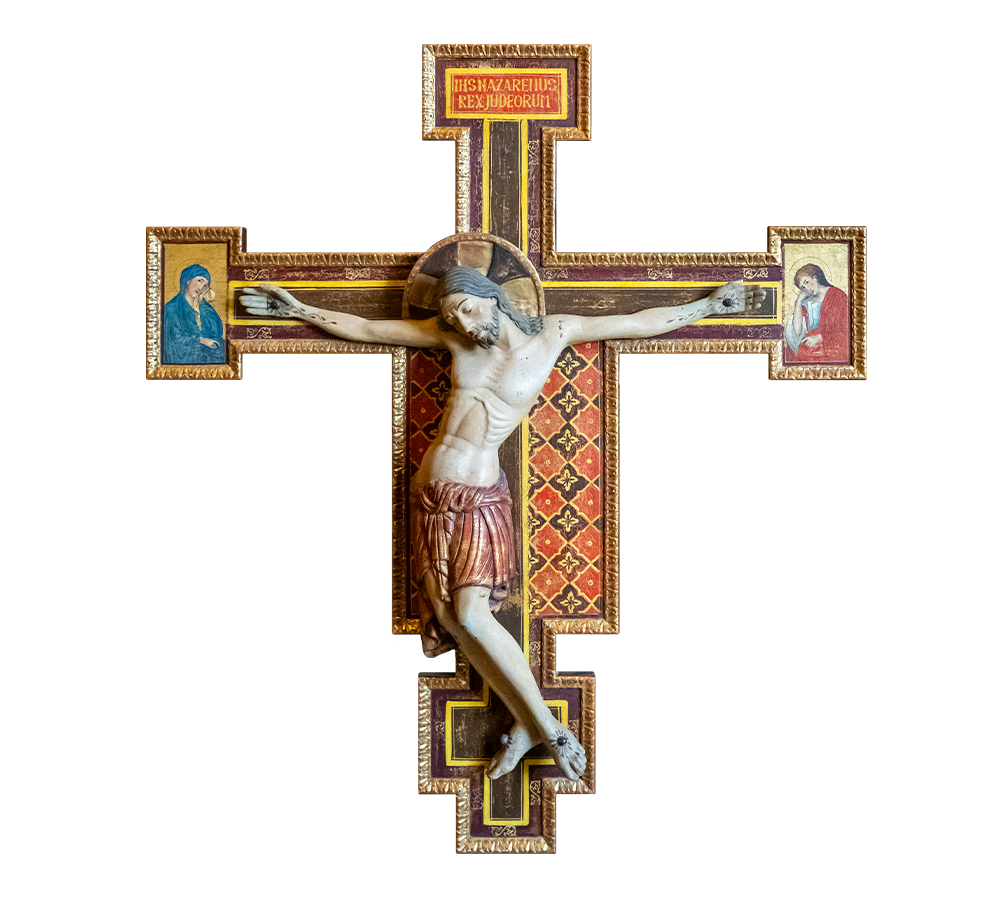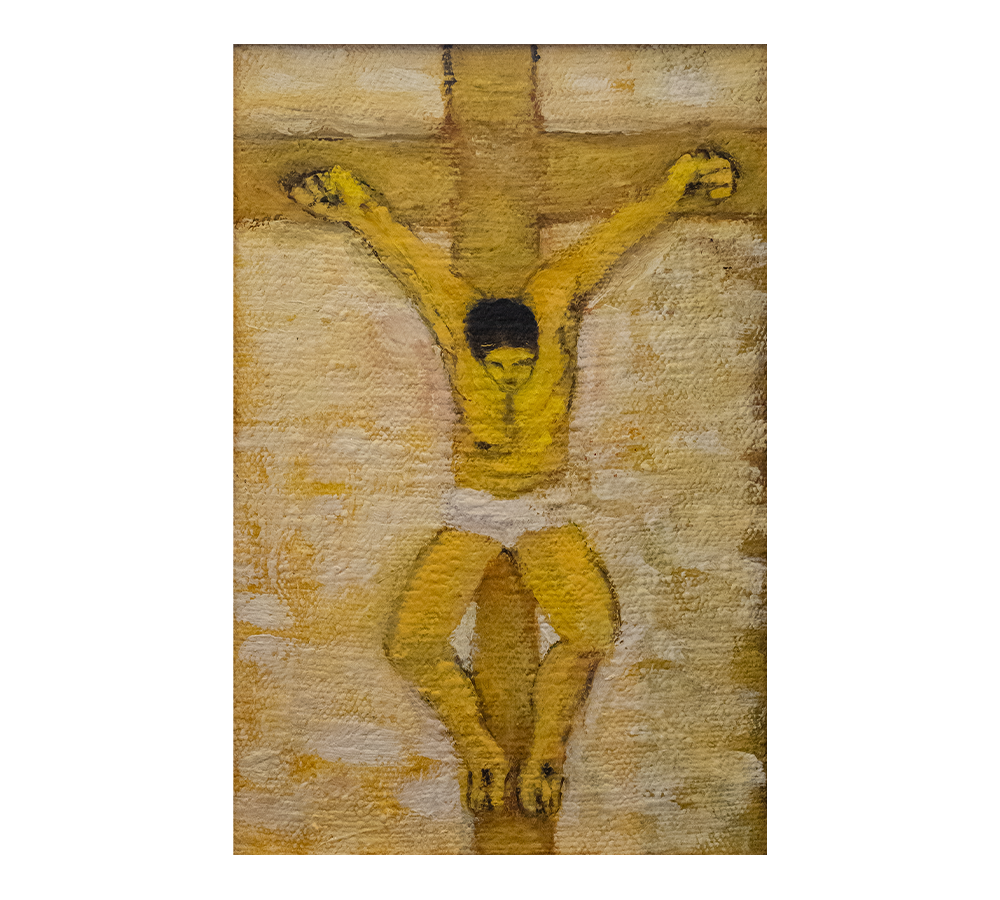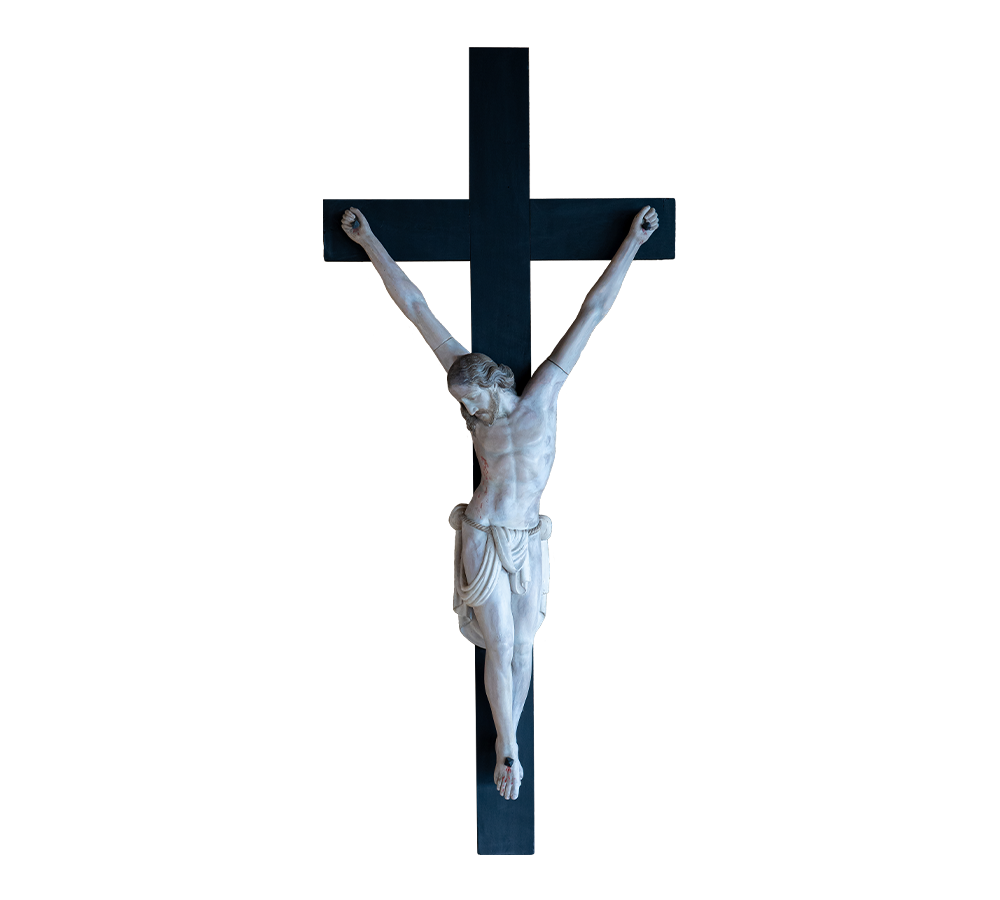Art of the Cross

Throughout the year, we focus on different pieces from the Abbey art collection. If you are inspired by seeing and learning about the art, please visit again.
Quarterly Virtual Exhibit: January, April, July, October
Providing a window into the art world of Mount Angel Abbey.

Throughout the year, we focus on different pieces from the Abbey art collection. If you are inspired by seeing and learning about the art, please visit again.
Quarterly Virtual Exhibit: January, April, July, October
Descriptions compiled by Br. Anthony Kamal, OSB.

Mural size: 75” x 150.5” (detail shown) | Acrylic, gold leaf
The Crucifixion scene, written by Br. Claude Lane, OSB, depicts Jesus hanging on a cross. His blessed mother, Mary, stands nearby, symbolizing the birth of the Church; and John, His beloved disciple, and brother are central figures. Consistent with sacred scripture, the scene is placed outside the walls of Jerusalem. Overhead, the dark blue heavens symbolizing divine wisdom shroud the red tile roofs of the city of Jerusalem, enclosed by the city’s outside walls. Jesus wears a cruciform halo, announcing, “I Am Who I Am.” The Greek inscription on the cross reads ICXC, which informs the viewer that this is Christ the King, which is common in Eastern iconography. Blood and water gushes from his right side, symbols of the water of baptism and blood of the Holy Eucharist. Blood flows from wounds on his feet onto a buried skull visible in a dark cave at the base of the cross. The skull represents the head of the Old Adam, who Christ, the New Adam, has replaced through his death on the cross.

Size: 24″ x 34” | Carved wood, paint
The design by Cimabue (c. 1240 – 1302) was converted to 3D sculpture by the Moroder Sculpture Studies in St. Ulrich-Groden, Northern Italy. This piece includes a special painted pattern background. Cimabue, also known as Cenni di Pepo or Cenni di Pepi, was an Italian painter and designer of mosaics from Florence. Although heavily influenced by Byzantine models, Cimabue is generally regarded as one of the first great Italian painters to break from the Italo-Byzantine style. While medieval art then was scenes and forms that appeared relatively flat and highly stylized, Cimabue’s figures were depicted with more advanced lifelike proportions and shading than other artists of his time.

Size: 20” x 14” | Marble carving
White marble bust of Christ showing part of the wood of the cross on which he hung. The marble has a slight translucency, i.e., subsurface scattering that is comparable to that of human skin. It is this translucency that gives a marble sculpture a visual depth beyond its surface, and evokes a certain realism.

Metal cast, silver plating
The crucifix has evangelist symbols on the four extremes of the cross and a flora halo behind the upper body of Jesus. Large metal cast corpus with silver plating. A beaded halo extended by a van around the upper part of Christ’s body. The cross is covered with strong repeating designs that decorate the top, bottom, and sides.

Size: 11.5” x 7.5″ | Oil on canvas
This painting of the crucifixion by Ugo Tesoriere is based on the crucifix on the staff of St. John Paul II, with the body of Christ leaning forward and the legs bent. The image of Christ is depicted without a beard.

Carved wood
Wood carved Corpus Christi with light polychromatic coloration. The style was influenced by the French heresy of Jansenism observed in the position of Christ with arms raised up rather than outstretched. Jansenism was a French heresy in the 17th and 18th centuries which stated that Christ died only for the elect few (the idea behind the vertical and more narrow position of the arms). Jansenism asserts that God’s role in the infusion of grace cannot be resisted and does not require human assent. It took root mostly in France, Italy, and the low countries. This style corpus reflected this belief at the time.

Oil on canvas
This piece based on Guido Reni’s Crucifixion (c 1617) depicts Mary and John standing at the foot of the cross with Mary Magdalene grasping the wood of the cross. In the background, the sky is turbulent at the 3 o’clock hour. The clothing of Mary and John is voluminous and colorful against a dark, ominous background.
 Size: 24″ x 24″ | Glass tile, stone
Size: 24″ x 24″ | Glass tile, stone
In this mosaic by Louisa Jenkins, Jesus’ shoulders are wrenched in this depiction of his death on the cross. Number twelve of the fourteen stations of the cross, the coloration is among the most beautiful. Jesus’ face is at peace and the background of the path is flanked with green and other colors of life. The piece demonstrates the peace brought on by self-abandonment and humility as expressed by the second Divine person.
 Size: 7.5” x 5.5” | Gouache on paper
Size: 7.5” x 5.5” | Gouache on paper
In this small piece by Jean Lambert-Rucki, the figure representing Christ on the cross dominates the right side of the painting, with tan line drawings to the left depicting Saints John and Mary. The background is a solid field of black.
If you know someone who may enjoy our exhibits, please pass the link on to them.
To see more of the Mount Angel Abbey Art Collection, please see the archive links below.
If you have a comment about this exhibit, or would like to add someone or take yourself off our “exhibit alert” email list, please contact us at theartcollection@mtangel.edu.
– Fr. Nathan Zodrow, OSB, Abbey Art Curator
Beckoned by Beauty: A New Creation
Displayed through March 31, 2025
Advent Homage to Mary
Displayed through December 31, 2024
Landscapes of the West
Displayed through September 30, 2024
Stories of our Favorite Art at the Abbey
Displayed through June 30, 2024
Vision in the Details
Displayed through March 31, 2024
Bright Medallions of Faith
Displayed through December 31, 2023
From the Sierras to the Pacific
Displayed through September 30, 2023
“Beauty given by Grace.”
Displayed through June 30, 2023
Illuminating the Hours
Displayed through March 31, 2023
Lost Rural Japan
Displayed through December 31, 2022
Salve Suite
Displayed through September 30, 2022
Alvar Aalto
Displayed through June 30, 2022
John August Swanson: Living Faith through Art
Displayed through March 31, 2022
Introducing the Painter: Ugo Tesoriere, 1923–2000
Displayed through December 31, 2021
Latin Calligraphy and Benedictine Life
Displayed through October 22, 2021
Year of St. Joseph
Displayed through July 14, 2021
Through the eyes of Jean Lambert-Rucki
Displayed through March 31, 2021
Louisa Jenkins and Friends: Sacred Mosaic Arts
Displayed through January 4, 2021